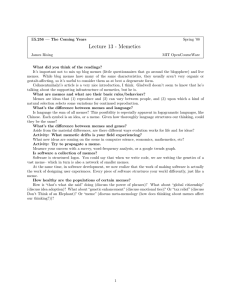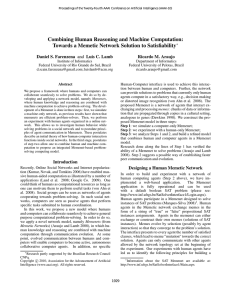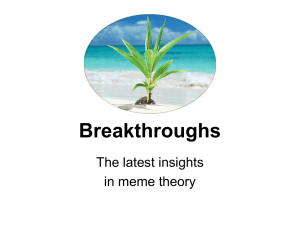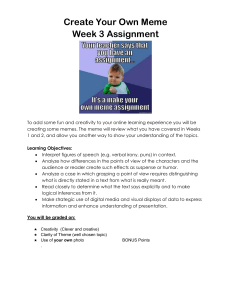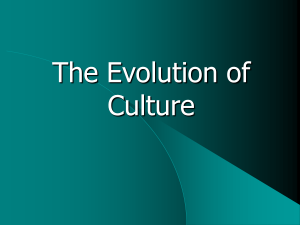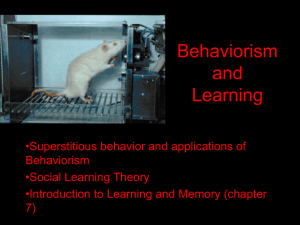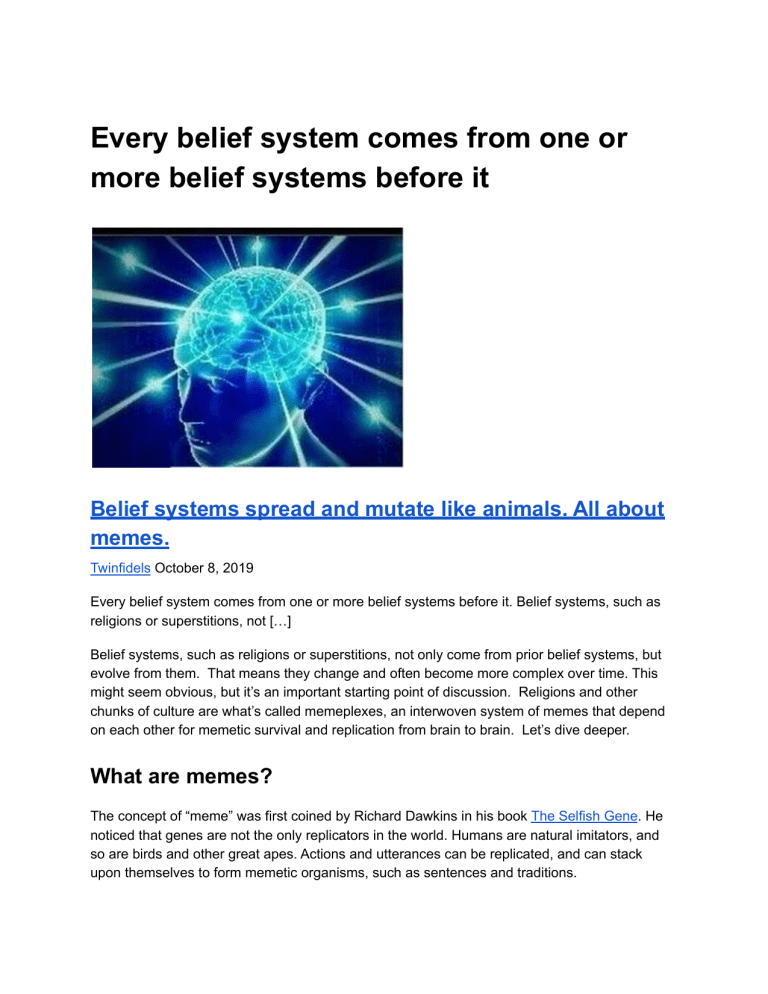
Every belief system comes from one or more belief systems before it Belief systems spread and mutate like animals. All about memes. Twinfidels October 8, 2019 Every belief system comes from one or more belief systems before it. Belief systems, such as religions or superstitions, not […] Belief systems, such as religions or superstitions, not only come from prior belief systems, but evolve from them. That means they change and often become more complex over time. This might seem obvious, but it’s an important starting point of discussion. Religions and other chunks of culture are what’s called memeplexes, an interwoven system of memes that depend on each other for memetic survival and replication from brain to brain. Let’s dive deeper. What are memes? The concept of “meme” was first coined by Richard Dawkins in his book The Selfish Gene. He noticed that genes are not the only replicators in the world. Humans are natural imitators, and so are birds and other great apes. Actions and utterances can be replicated, and can stack upon themselves to form memetic organisms, such as sentences and traditions. Memes are bits of culture that can be transmitted from one brain to another. An idea. But not just an idea, anything that can be copied and spread by imitation. And memes don’t affect just humans. Birds learn songs and flight formations from other birds. Chimps and orangutans teach other members of their groups things like how to use tools, how to treat others… and even a bit of fashion => For The First Time, Chimpanzees Are Making A Fashion Statement — Sticking Blades Of Grass In Their Ears. Most memes are active, meaning that they are affecting the behavior of the host brain. Inactive memes, don’t. An example of inactive memes would be Christian related ideas residing within a non-practicing, non-professing Christian. Susan Blackmore explains the concept of memes brilliantly in her book The Meme Machine. If books are too laborious for you, at least watch her Ted Talk shown at the bottom of this post. Memes have three main properties when considering their “survival.” Longevity. The lifespan of the meme. Friendship bracelets and The Macarena did not have impressive longevity. But holiday carols do. Fidelity. How perfect and unmutated the memetic copies are. Writing helps with fidelity, but translations butcher it. Biblical messages spread like wildfire, but the fidelity of the messages were abysmal. You end up with Bibles conveying completely different messages. Fecundity. The spread and number of copies the meme among minds. What the Macarena and other viral dances lack in longevity, they make up for in fecundity. “Everyone’s doing it.” Spoken words are memes that you can pronounce. Memes travel around from person to person and are subject to mutation, and words are no exception. That’s why there are dialects and accents. Even though words are largely normalized back to an accepted standard version due to schooling, they can change once a group of people break away from the standardizing population and start pronouncing words their own way. The British insist on pronouncing “Military” like “Militry”, even connect two words like “at all” to sound like “a-tall”. But they had the language first, so how can I say they’re wrong? Americans broke off from the mother country and slowly the language morphed to something distinct from that of the British. Fashion trends, recipes, music, dance, taboos, slogans, catch-phrases and any other transmittable piece of culture are all memes. Memes behave like genes in that they replicate and mutate. Memes and genes are analogous. It’s so fascinating to spot the similarities. Just as there is genetic evolution, there is also memetic evolution. Memetic Evolution The phenomenon of memes changing over time is memetic evolution. It is also known as cultural evolution. There may be several different drivers of memetic evolution like there is for genetic evolution. Genetic evolution is driven by natural selection, group selection, sexual selection, artificial selection, and perhaps many others. Change over time is not necessarily always driven by selection (i.e. may the best meme win). Memes are subject to drifting. Memetic drift is the accumulated misreplication of memes. People imitate well, but they don’t imitate perfectly. So naturally, memes change over time via drifting, unless there’s a standardizing protocol (like an established alphabet, for example) to prevent it. Verbal expressions are an interesting example of drifting memes. People don’t call each other “knave” or “skallywag” anymore. People don’t bite their thumbs at others insultingly. “Dare you bite your thumb at me, sir?” By the way, old timey sayings are always fun to read and hear. There’s a list of hilarious old timey expressions here. “Shook my hand like a wet sock.” Ha! Priceless. Writing slows the memetic drift of dogmas and other memeplexes. Before writing became mainstream in the ancient world, epic tales were transmitted largely in poem or song format, which also added resistance to the memetic drift of the tales. Memeplexes? Memes that combine to form an interdependent body of memes are memeplexes. The memes evolved and exist symbiotically among themselves and co-assist, strengthening the system of memes and making their effects on minds more potent. Languages, traditions, customs, political affiliations, social movements and religions are memeplexes. Because memeplexes are an interconnecting system of memes, the crumbling or poisoning of one meme often affects supporting memes. This is how many people lose their faiths over time. An easy example would be believing the meme of Jesus dying for the sins caused by Adam. But an education in evolutionary anthropology competes and eventually snuffs out the belief that there has ever been a first man or woman. No Adam means no original sin. No original sin means no need for Jesus. Christianity crumbles from there. Furthermore, if a meme is changing due to surrounding pressures of other memes or other reasons, it could pull other memes in the memeplex with it. Take the following scenario as an example: Meme: Mary, an imperfect woman, gave birth to a perfect son. Women do not contribute genetically to their offspring, they are merely “ovens” for the “buns”. Children inherit nothing from the mother. Original sin is inherited from father to child, all the way back to Adam (which is why it was a big deal for Adam eating the forbidden fruit, not Eve.) Competing meme: Genetic material is found in the ovum in 1827, proving that women do indeed pass genes (and indeed, sin) on to their children. Meme mutation: Jesus inherits original sin from Mary? => Nope, Jesus cannot inherit sin => Mary BECOMES perfect by virtue of the conception => Mary deemed to be the only perfect non-divine being to have lived. The Catholic memeplex has now shifted to include a new meme called the Immaculate Conception as a response to the scientific discovery in the early 1800’s. Meme Migration Memes and genes act similarly. The longer a population lives in one area, the more genetic diversity will naturally arise and accumulate. That is why there is more genetic diversity in Africa among humans than in any other continent, because humans spent more time there in their anthropological history. Look at those faces! Look at the diversity! Look at it! As a matter of fact, there are Larger Genetic Differences Within Africans Than Between Africans and Eurasians. Mind. Blown. Take a look at this map that depicts humans originally from East Africa around 2 million years ago migrating up and through the Middle East, and spreading out from there. When mapping the trek of human migration out of Africa, genetic diversity diminishes the further along the trek is. Humans migrated to the southern tip of South America (Patagonia) around 12,500-14,500 years ago, much less time than human presence in Africa, so there’ll be must less genetic variation. The same is true for accents. Take English for example. Because the English language spent more time in England than anywhere else, memetic diversity accumulated. That is why there are many more English accents than American Accents. Take a look at the accent map in the U.K. Each little colored splotch is a distinct British accent. If you drive 20 miles in any direction, you’ll hit a new regional accent. The English language had time to accumulate that variety in that area. Thousands of years. But compare that to American English. The dialectal regions are huge and few in comparison to those of the mother country. The same will be true for other colonizing countries and their colonies. When it comes to genetic diversity and languages, gene and meme pools foamed and frothed with variation before given the chances to spill out with the help of transportation and the internet. Scotland, Ireland, Australia, America are all English speaking nations that have had some degree of isolation from each other. All of their dialects differ significantly as a result. I can hardly understand Scottish at this point. It might as well be its own language. Speciation of Memeplexes When two populations of living things are able to mate and create fertile offspring, they are considered the same species. But over time, if the populations remain isolated, they slowly mutate, individual by individual, until the whole group is a bit different from the parent group. Producing fertile offspring will become less and less frequent until the two groups can no longer do so. In much the same way, chimps, humans, and the other great apes all share a common ape-like ancestor. That ancestor did not give birth suddenly to a gorilla or an orangutan. The change from that ancestor to the modern great apes was an extremely slow process. Isolation was necessary for the process to occur. Time plus isolation equals evolution. We are witnessing the speciation of mosquitoes right before our eyes. There is a population of mosquitoes that have broken off from the parent group and began to thrive underground in the London subway tunnels. They feast on the blood of people and rats. These mosquitoes are becoming a new species from the mosquitoes above ground. Which means they soon will no longer be able to produce fertile offspring. Languages can speciate too. As mentioned before, Scottish English and American English are nearly mutually intelligible. In another 50 years, who knows, they may be two distinct languages. Ease of travel and constant communication among groups nowadays slows the speciation process. It prevents true isolation. Technology has catalyzed extreme genetic and memetic mixing over the years. Races and cultures everywhere will increasingly blend and blur as the years go by. Thinking about languages, it is well known that Italian comes from Latin. But we all know that a Latin speaking mother did not give birth to an Italian speaking daughter. The language slowly changed over time and diverged into the other Romance languages like Romanian, French, and Spanish. They all share Latin as their linguistic ancestor, but now are distinct languages in their own rights. They speciated, yet each sharing abounding commonalities. It’s easy to spot how French and Spanish, Polish and Russian, Japanese and Cantonese, Swedish and Icelandic are closely related to each other just as it’s easy to spot close relation between dogs and bears. Which now brings us to the speciation of religions. Christianity and Islam broke off from Judaism, becoming distinct religions. Protestantism broke off from Catholicism, and while still of the same religion, they may speciate completely in time. I have heard many times from Protestants that Catholics are not Christian. If such talk becomes more convincing and fervent writ large, then speciation will occur. The same goes for Mormonism. Many Protestants and Catholics would swear up and down that Mormons are not Christian. Mormonism budded off of Protestantism in the 1800’s. Mormons have their own holy book and special holy figure, Joseph Smith. They even have their own “pope.” The rules that apply to them do not apply to the other Christians. Their creation story is different, as well as their view of the afterlife. It appears to me that the only thing keeping Mormonism under the Christian umbrella is the occasional mention of Jesus. But in short time, I believe, Mormonism will become a separate religion completely, with lesser Mormonic denominations budding off from it, creating a new branch in the religious lineage. Genealogy of Memes If memes and genes are so alike, that would mean that not only is there a Tree of Life, but also a Tree of Language and a Tree of Religion. Well, I’m glad you mentioned it. That’s exactly right. All such Trees show how simple things diverge and branch off into the diversity we see today. The Trees show how everything is related and come from simple beginnings. Let’s take a look at a typical Tree of Life. The tree of life has three primary branches: Bacteria, Archaea, and Eucaryotes The origin of life is simple and as you move up from there, the organisms tend to get more complex. But they don’t have to. Sometimes it’s better for an organism’s survival to become simpler when the circumstances arise. The key thing to note is the branching. More and more branches of life sprout as time progresses. Genetic evolution is the phenomenon that is behind the diversity of all life. Trees of Life come in different shapes, sizes, and complexities. Like the one here, which also shows a timeline. As you can see, all life can trace its lineage back to the simple bacteria. Over time, life diversified to form archaea, then all eukaryotes like protists, fungi, plants, and animals. Everything’s related and connected. Now let’s look at a Tree of Languages. Here are two And here’s the more complex tree with dates included As expected, the Tree of Life is going to be more comprehensive than the Tree of Language. Biology, evolution, and the Tree of Life have been refined and tested and built up by more scientists and for a longer period of time than the other trees we will discuss. The Trees of Language above goes back to 5000 BCE, to proto-Indo-European. That is the mother of all European and Asian languages, but not African. Humans have been talking for much longer than 7000 years. And since the first humans came out of East Africa, I’d like to see a Tree of Language that would go back that far, say, 100,000 years or more. But unlike lifeforms, languages do not fossilize. They are merely written, and that’s how far back the Tree of Language goes, to the earliest forms of writing discovered. But still, the Tree of Language shows that all languages are connected. And like biological life, the earlier forms of the language will be simpler forms. Modern English has around 180,000 words (not including medical jargon, modified forms; i.e. dog, but not dogs; bang, but not banged.) By contrast, Old English had only around 60,000 words. It’s expected that the further back in time you go, the simpler the language with fewer words. As a matter of fact, a good indicator for the age of language is the number of words the language has for colors. Names for colors get added over time, so the language with the most names for colors will most likely be the oldest language. Okay, time for the Tree of Religion. Take a look. The tree indicates that the ancestor to all religions is a form of Animism, which is a belief that all moving things, including animals, trees swaying in the wind, and the wind itself, are all controlled by good and evil spirits that can be communed and controlled through religious rituals. Animists believe in a supreme “Sky God.” The notion of many gods came much later. All organized religions developed and accumulated their intricacies from the humble beginnings of folk religions where there were no hierarchies of priests or opulent buildings and vestiges, only village shamans in huts. Just like there are still simple bacteria today, there are simple folk religions today. Looking at the Tree of Religion fascinated me. According to the tree, Judaism gave birth to Christianity, Islam, and Hellenistic Judaism. Hellenistic? That means that the Greeks got in there and morphed things up. It makes sense. The New Testament was originally written in Greek, after all. Will look into this a bit more later. Because protestants do not have a central leader like the catholic church or the eastern orthodox church, the protestant belief system does not self-normalize. Groups continue to break off to form new denominations continually. Memetic drift is unrestricted. Let’s take a general look at Christian branches Shortly after Martin Luther’s Protestant reformation, 5 denominations of Christianity sprouted. Today, there are thousands. We can go more detailed with a tree that includes dates Notice the branching. And the tree will continue to branch because that is what memes do. They spread, mutate, branch off, and diversify. This particular tree depicts a common ancestor of all Christian faiths bubbling up at around 70 CE. What was happening then? What were the surrounding belief systems at that time? What antecedent conditions arose for Christianity (at it’s most primitive form) to sprout up and promulgate? These genealogical trees help us to ask the questions. But doesn’t stop there. ALL memeplexes have genealogies (or memealogies.) Even dance Morality also has a genealogy, as described by Friedrich Nietzsche You can read more on Nietzsche’s Genealogy of Morality here. According to Nietzsche, human morality can be traced back to simple ancestor worship and the will to achieve power. Concepts of morality replicated, mutated, and diversified from there to the various forms of morality we see today. Vertical and Horizontal memetic transmission Traditions passed down from generation to generation are memes passed down vertically. Dances and songs shared among friends are memes passed across horizontally. Religions largely rely on vertical transmission. Children are vulnerable to indoctrination due to lack of critical thinking skills and education, compiled with an untarnished trust in parents. Using horizontal transmission only, like some cults (the Church of Euthanasia, for example) would require the memeplex to use strategies other than childhood indoctrination to propagate successfully. Memetic Ecosystems Just like living organisms, memes thrive in some environments and perish in others. In the medical field, if you are observed by your colleagues doing something well, the common praise you’ll hear is, “Strong work on that.” But you won’t something like that in other professions. No rhyme or reason to it. It is what it is. Many Religions die in the light. Like bacteria. Exposure to outside information compromises the influence they have on their hosts. That is why many cults and religions like Scientology, Mormonism, Islam, and Jehovah Witnesses forbid their members to surf around on the net or mingle with non-believers. A steady temperature and humidity of isolation and ignorance keep the memeplex healthy and potent. Everything Memetics I could go on and on. The science of memetics is so fascinating. It combines sociology and evolution. There are many avenues to go from here: fashion trends, linguistic change, even advertising. But what percolates in my mind the most is how the belief in the supernatural changes over time. If memetics piques your curiosity, too, there is a quick memetics glossary of what looks like more than a hundred memetics related terms. You’ll find interesting stuff like co-meme, earworm, failed meme, membot, retromeme, teme, and so much more. You can find that glossary here. My quick Teme Experience Temes are techno-memes, or technologies that replicate and change over time. Smart phones evolve and multiply so fast. I remember when flip phones evolved into slide phones, and weren’t too common. Now, smart phones capable of downloading apps are more complex than all the phones before them and are more numerous than people on the planet. Currently, temes require humans for replication, but soon AI will find a way to reproduce itself, I’m sure. Anyway, once upon a time I was working in an old school that ran in the 1960s. That building was shut down and reused to be a community center decades later, with much of the space left unused. I remember walking down the abandoned corridor, and looking into the old offices. Nothing was cleaned out. The offices looked like there had be a zombie apocalypse just months prior. Papers and files still strewn on the desks. Cups knocked over. It was eerie. One room as peculiar. No desks, just dumped technology. Printers, fax machines, desk phones, piled so much that you couldn’t see the floor. You could tell that over the years, instead of throwing old technology out when new tech came in to replace it, people just tossed the junk in this room. The top layer of tech were items from only a few years back. But the further down you dig, the older the technology got. The phones that could touch the floor were the rotary phones. It was an archaeological dig of technology. And you could see plainly how temes multiplied, mutated, and got more complex over time. For instance, the newer desk phones eventually acquired nifty mutations on their faces called “hold” and “transfer” buttons. Temes go through extinctions, too. Temes, memes, and genes all compete among each other for survival and replication. They die off when the competitors are stronger, more fruitful, more compelling, cheaper, more adaptive, etc. The Windows phone couldn’t compete with the i-Phone Neanderthals couldn’t compete with Cro-Magnon Mithraism couldn’t compete with Early Christianity Susan Blackmore, Queen of Meme Listen to Susan Blackmore tell you all about memes and temes in her TED talk. What this all means Since all religions, with some exceptions like Scientology, came from prior forms of that religion, we can always ask ourselves guiding questions. Where did the story of Adam and Eve come from? Story of Noah? Job? The idea of Satan? The idea of Heaven and sin? How did these ideas change over time? What were the memetic ecosystems they used to thrive in? Are they still thriving in the memetic ecosystems of today? What are the competing memes that’re catalyzing the evolution of religious memes so they can survive? What defense mechanisms do some of these religious memes use to protect themselves from mutation, becoming inactive, or dying off altogether? What offense mechanisms do they use to zombify their hosts (as in cults) and turn them into meme fountains, “spreading the word” wherever they go? This blog is a deep dive into all of these questions. Join us. Add your two cents. We are not experts. We are two curious twins who want to learn more about the origins of these memes and how they impact society today. Take a look at the Tree of Religion. What questions do you have? What are the ancestors of your current or prior belief systems? Has this post piqued your curiosity about anything in particular? Is there anything to add? Let us know in the comments!
